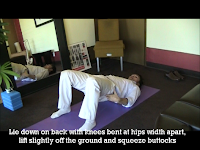Another great stretch for the low back and hip regions is the twist stretch. A bit different than your typical piriformis stretches, the twist stretch hits the piriformis, glutes and lumbar spine erector spinae (or paraspinals). Because of this, the twist stretch is great for relieving low back pain, hip pain, piriformis syndrome, and can even help in some cases of sciatica.
Watch the video below to learn the best technique for doing the twist stretch. The key that you must remember when doing this low back stretch is to keep your lower back straight, so sitting up straight before twisting is imperative. If you fail to do this important step, you do risk the potential for injury. I find this point so important because I observe many people at the gym doing a twist stretch with rounded backs. Listen, if you want to come see me as a herniated disk patient, then twist with a rounded back. But if you would rather fix your low back pain, then twist with a straight back–simple as that. Have fun twisting.














